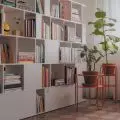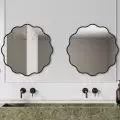Daniel Bobrowski, Paulina Gierat, Martyna Radzik, Kamila Szpil and Zuzanna Ścibura from the Faculty of Architecture at the Silesian University of Technology, as part of the class "Urban Design of Residential Complexes" under the supervision of Prof. Alina Pancewicz, developed a design for a modern neighborhood in Dąbrowa Górnicza. The design team faced the challenges of a difficult site on the border with Będzin, taking into account specific technical and environmental conditions.
board
© Daniel Bobrowski, Paulina Gierat, Martyna Radzik, Kamila Szpil, Zuzanna Ścibura
existing state
The site in Dąbrowa Górnicza is a design challenge that the students had to take into account in their solutions. There is a sewage treatment plant near the plot, which is a significant constraint from a land use perspective. In addition, the plot borders a railroad station and is located on waterlogged ground, requiring special drainage solutions. The site is also crossed by technical infrastructure, including gas lines, power lines and district heating networks. The surrounding single-family housing affects the design possibilities, but the proximity to the Pogoria River opens up recreational potential, which has been exploited in the project.
board
© Daniel Bobrowski, Paulina Gierat, Martyna Radzik, Kamila Szpil, Zuzanna Ścibura
design solutions
The project involves the creation of a district based on the concept of a 15-minute city, where all necessary services and amenities are within walking or biking distance. The district has been designed with the diverse needs of all age groups in mind, promoting a healthy lifestyle and minimizing the need to use cars. The zoning of the plot takes into account the terrain and existing technical infrastructure. Along the gas and heat lines, low-intensity single-family housing was designed, offering spacious and peaceful living conditions. The central part of the district, with multi-family development, provides easy access to key services, while more intensive development has been located in areas less prone to flooding. Green infrastructure, including ecological corridors and greenbelts, plays a key role in the project, improving aesthetics and providing access to recreational areas. Recreational spaces have been designed around the water reservoirs at the wastewater treatment plant, fostering social integration and active lifestyles.
The district's main transportation axis has been clearly marked and surrounded by a variety of services, such as bicycle transfer points, encouraging residents and residents to use environmentally friendly means of transportation. The services are distributed evenly throughout the district, allowing users and users to quickly access amenities such as a kindergarten, a day care center for seniors, a greenhouse or a clinic. The project is distinguished by its spatial diversity. A market and an orchard are planned along the heat pipes, adding variety to the public space and promoting outdoor activities. The development varies in typology - from multi-family near the sewage treatment plant to single-family, including detached houses, terraced houses and semi-detached houses, with plots of various sizes. The high intensity of development, located at a safe distance from the wastewater treatment plant, ensures efficient use of available space.
board
© Daniel Bobrowski, Paulina Gierat, Martyna Radzik, Kamila Szpil, Zuzanna Ścibura
blue-green infrastructure and sustainable mobility
The project places great emphasis on the integration of blue-green infrastructure. Green belts, a market and an orchard create a network of ecological spaces that favor local ecosystems and provide residents with close contact with nature. The proximity of water bodies and recreational areas further enriches the project and emphasizes its sustainable character. The district is well connected thanks to pedestrian and bike paths. A central bus stop facilitates access to public transportation, and underground parking lots minimize the impact of automobile traffic on public space.
board
© Daniel Bobrowski, Paulina Gierat, Martyna Radzik, Kamila Szpil, Zuzanna Ścibura
social activity and integration
The project promotes an active lifestyle through a wide range of recreational spaces, such as sports fields, sports arenas, playgrounds, bicycle paths, pumptrack, skatepark and an environmental education center. The concept also includes a recreation area for animals, further enhancing the district's attractiveness.
The district responds to contemporary social and environmental needs, combining sustainable development with functional and spatial diversity. Thoughtful urban planning solutions create a resident-friendly space that promotes health and social integration.



























